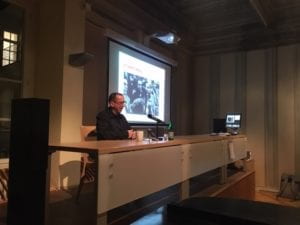
Recently Nicholas Mirzoeff, a professor in the Department of Media, Culture and Communication at New York University, spoke at NYU Prague to celebrate the launch of the Czech translation of his most recent book, How To See The World.
The British-born Nicholas Mirzoeff is a visual activist who is considered a founder of the academic field of visual culture. He researches the intersection of politics and visual culture. How to See the World has been translated into ten languages and was a New Scientist Top Ten Book of the Year for 2015.
Mirzoeff writes: “In recent decades, we have witnessed an explosion in the number of visual images we encounter… from Google Images to Instagram, video games to installation art. This transformation is confusing, liberating and worrying all at once, since observing the new visuality of culture is not the same as understanding it.”
He feels strongly about making his ideas accessible to the public. He frequently posts articles on his free blog, and in 2017 he published The Appearance of Black Lives Matter as a free e-book. He also tries to spread his expertise, running workshops for NGOs on how to get their messages across using images. Since the Charlottesville protest in 2017 he has been active in the movement to take down statues commemorating white supremacy. He helped put together a crowd-sourced collection of materials relating to Confederate monuments which can be accessed at All The Monuments Must Fall.
His recent guest lecture at NYU Prague was coordinated in partnership with Artmap, his Czech publisher, and Fresh Eye, a local Czech platform for the development of visual cultural studies. Both international and Czech students were in the audience including a group who are studying in the newly-created visual culture department of Palacky University in Olomouc.
Mirzoeff plans to return to Prague in the fall to offer a workshop for local activists, teaching them to use visual activism more effectively, as Black Lives Matter has achieved. NYU Prague will coordinate the event which will bring together academics, activists, and Czech and international curators. Among the new collaborators in this projects is Julia Baily, a curator of the Czech National Gallery who used to work at the Tate Gallery and whose research focuses on art during the Cold War.
Visual culture gives activists tools but these can also easily be used against them. “The present is both dangerous and saturated with visualizing technology from the drone to CCTV and Instagram. Many of these technologies create danger for the watched, even as social media can be a resource for the asylum seeker and the protestor.”

